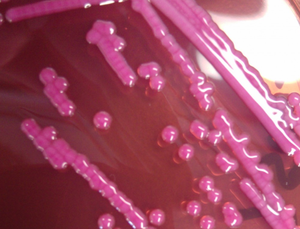Lower
temperatures used in 'energy saver' washing machines may not be killing all
pathogens
American
Society for Microbiology
 For
the first time ever, investigators have identified a washing machine as a
reservoir of multidrug-resistant pathogens. The pathogens, a single clone
of Klebsiella oxytoca, were transmitted repeatedly to newborns in a
neonatal intensive care unit at a German children's hospital.
For
the first time ever, investigators have identified a washing machine as a
reservoir of multidrug-resistant pathogens. The pathogens, a single clone
of Klebsiella oxytoca, were transmitted repeatedly to newborns in a
neonatal intensive care unit at a German children's hospital.
The transmission
was stopped only when the washing machine was removed from the hospital. The
research is published this week in Applied and Environmental
Microbiology, a journal of the American Society for Microbiology.
"This
is a highly unusual case for a hospital, in that it involved a household type
washing machine," said first author Ricarda M. Schmithausen, PhD.
Hospitals normally use special washing machines and laundry processes that wash
at high temperatures and with disinfectants, according to the German hospital
hygiene guidelines, or they use designated external laundries.
The
research has implications for household use of washers, said Dr. Schmithausen,
Senior Physician, Institute for Hygiene and Public Health, WHO Collaboration
Center, University Hospital, University of Bonn, Germany.
Water temperatures
used in home washers have been declining, to save energy, to well below 60°C
(140°F), rendering them less lethal to pathogens. Resistance genes, as well as
different microorganisms, can persist in domestic washing machines at those
reduced temperatures, according to the report.
"If elderly people requiring nursing care with open wounds or bladder catheters, or younger people with suppurating injuries or infections live in the household, laundry should be washed at higher temperatures, or with efficient disinfectants, to avoid transmission of dangerous pathogens," said Martin Exner, MD, Chairman and Director of the Institute for Hygiene and Public Health, WHO Collaboration Center, University Hospital/University of Bonn.
"This is a growing challenge for hygienists, as the number of people
receiving nursing care from family members is constantly increasing."
At
the hospital where the washing machine transmitted K. oxytoca,
standard screening procedures revealed the presence of the pathogens on infants
in the ICU. The researchers ultimately traced the source of the pathogens to
the washing machine, after they had failed to find contamination in the
incubators or to find carriers among healthcare workers who came into contact
with the infants.
The
newborns were in the ICU due mostly to premature birth or unrelated
infection.The clothes that transmitted K. oxytoca from the
washer to the infants were knitted caps and socks to help keep them warm in
incubators, as newborns can quickly become cold, even in incubators, said Dr.
Exner.
The
investigators assume that the pathogens "were disseminated to the clothing
after the washing process, via residual water on the rubber mantle [of the
washer] and/or via the final rinsing process, which ran unheated and
detergent-free water through the detergent compartment," implicating the
design of the washers, as well as the low heat, according to the report.
The
study implies that changes in washing machine design and processing are
required to prevent the accumulation of residual water where microbial growth
can occur and contaminate clothes.
However,
it still remains unclear how, and via what source the pathogens got into the
washing machine.
The
infants in the intensive care units (ICU) were colonized, but not infected
by K. oxytoca. Colonization means that pathogens are harmlessly
present, either because they have not yet invaded tissues where they can cause
disease, or because the immune system is effectively repelling them.
The
type of multidrug resistance in the K. oxytoca is caused by
extended spectrum beta-lactamases (ESBL). These enzymes disable antibiotics
called beta lactams. The most common types of bacteria producing ESBLs are Escherichia
coli, and bacteria from the genus Klebsiella.